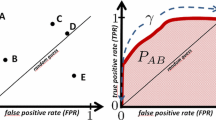Abstract
Learning Vector Quantization (LVQ) is a powerful supervised learning method for classification that uses a network of prototype vectors to form a decision surface. Generalization theory shows there is a non-trivial number of prototype vectors that yield the best generalization. Although it is typical to assign the same number of prototype vectors for each class, other LVQ methods add prototypes dynamically (incrementally) during training. This work offers an extension to the existing dynamic LVQs that minimizes the cost function of Generalized LVQ by focusing on the set of misclassified samples. This cost minimization occurs between the largest cost-contributing class and its nearest “confuser class”. A comparison is made between other prototype insertion methods and compares their classification performance, the number of prototype resources required to obtain that accuracy, and the impact on the cost function.
Access this chapter
Tax calculation will be finalised at checkout
Purchases are for personal use only
Similar content being viewed by others
References
Kohonen, T.: The self-organizing map. In: Proceedings of the IEEE, vol. 78, no. 9, pp. 1464–1480, Sept 1990
Losing, V., Hammer, B., Wersing, H.: Interactive Online Learning for Obstacle Classification on a Mobile Robot. IEEE (2015)
Kirstein, S., Wersing, H., Körner, E.: Rapid online learning of objects in a biologically motivated recognition architecture. In: German Pattern Recognition Conference DAGM, pp. 301–308 (2005)
Schleif, F.M., Villmann, T., Hammer, B.: Local metric adaptation for soft nearest prototype classification to classify proteomic data. In: International Workshop on Fuzzy Logic and Applications, Lecture Notes in Computer Science, vol. 3849, pp. 290–296. Springer (2006)
Mendenhall, M.J., Merényi, E.: Relevance-based feature extraction for hyperspectral images. IEEE Trans. Neural Netw. (2008)
Crammer, K., Gilad-bachrach, R., Navot, A., Tishby, N.: Margin analysis of the lvq algorithm. In: Advances in Neural Information Processing Systems, pp. 462–469. MIT press (2002)
Poirier, F.: DVQ: dynamic vector quantization application to speech processing. In: Second European Conference on Speech Communication and Technology, EUROSPEECH 1991, Genova, Italy, 24–26 Sept 1991
De Stefano, C., D’Elia, C., Marcelli, A., di Frecac, A.: Improving dynamic learning vector quantization. In: 18th International Conference on Pattern Recognition ICPR 2006, vol. 2, pp. 804–807 (2006)
Kohonen, T.: Self-organizing Maps, 3rd edn. Springer (2000)
Sato, A., Yamada, K.: Generalized learning vector quantization. In: Advances in Neural Information Processing Systems, pp. 423–429. The MIT Press (1996)
Grbovic, M., Vucetic, S.: Learning vector quantization with adaptive prototype addition and removal. In: Proceedings of the 2009 International Joint Conference on Neural Networks IJCNN’09, pp. 911–918. IEEE Press, Piscataway, NJ, USA (2009). http://dl.acm.org/citation.cfm?id=1704175.1704308
Bermejo, S., Cabestany, J., Payeras, M.: A new dynamic lvq-based classifier and its application to handwritten character recognition. In: ESANN, pp. 203–208 (1998)
Kietzmann, T.C., Lange, S., Riedmiller, M.: Incremental GRLVQ: learning relevant features for 3D object recognition. Neurocomput. 71(13–15), 2868–2879 (2008). http://dx.doi.org/10.1016/j.neucom.2007.08.018
Zell, A., Mamier, G., Vogt, M., Mache, N., Hübner, R., Döring, S., Herrmann, K., Soyez, T., Schmalzl, M., Sommer, T., Hatzigeorgiou, A., Posselt, D., Schreiner, T., Kett, B., Clemente G., Wieland J.: Stuttgart Neural Network Simulator (SNNS): User Manual, Version 4.1 (1995)
Lichman, M.: UCI Machine Learning Repository (2015). http://archive.ics.uci.edu/ml
Hull, J.J.: A database for handwritten text recognition research. IEEE Trans. Pattern Anal. Mach. Intell. 16(5), 550–554 (1994)
Merényi, E., Farrand, W., Taranik, J., Minor, T.: Classification of hyperspectral imagery with neural networks: comparison to conventional tools. EURASIP J. Adv. in Signal Process. 2014(1), 71 (2014). http://asp.eurasipjournals.com/content/2014/1/71
Higuera, C., Gardiner, K.J., Cios, K.J.: Self-organizing feature maps identify proteins critical to learning in a mouse model of down syndrome. In: PLoS ONE 10(6): e0129126 (2015)
Hastie, T., Tibshirani, R., Friedman, J.: The elements of statistical learning. In: Springer Series in Statistics. Springer New York Inc., New York, NY (2009)
Merényi, E., Singer, R.B., Miller, J.S.: Mapping of spectral variations on the surface of mars from high spectral resolution telescopic images. Icarus 124, 280–295 (1996)
Acknowledgments
The authors would like to thank Dr. E. Merényi for making the LCVF data set available for this work. The views expressed in this paper are those of the authors and do not reflect the official policy or position of the United States Air Force, the U.S. Department of Defense, or the U.S. Government.
Author information
Authors and Affiliations
Corresponding author
Editor information
Editors and Affiliations
Rights and permissions
Copyright information
© 2016 Springer International Publishing Switzerland
About this paper
Cite this paper
Climer, J., Mendenhall, M.J. (2016). Dynamic Prototype Addition in Generalized Learning Vector Quantization. In: Merényi, E., Mendenhall, M., O'Driscoll, P. (eds) Advances in Self-Organizing Maps and Learning Vector Quantization. Advances in Intelligent Systems and Computing, vol 428. Springer, Cham. https://doi.org/10.1007/978-3-319-28518-4_31
Download citation
DOI: https://doi.org/10.1007/978-3-319-28518-4_31
Published:
Publisher Name: Springer, Cham
Print ISBN: 978-3-319-28517-7
Online ISBN: 978-3-319-28518-4
eBook Packages: EngineeringEngineering (R0)




